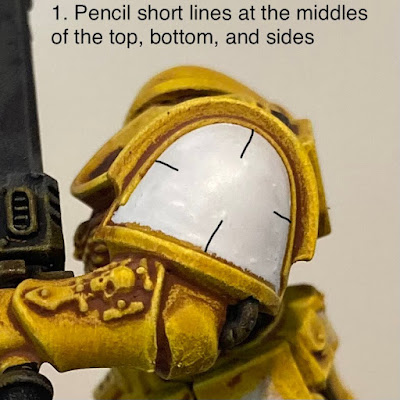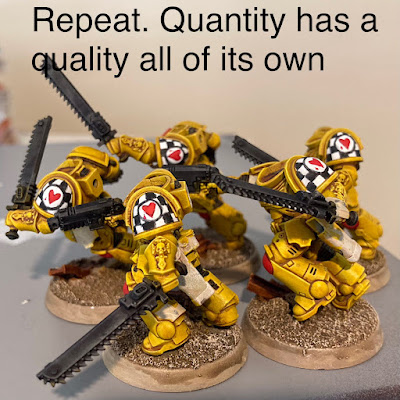The Lamenters have a famously challenging chapter badge. Here's why I find it challenging:
- straight, parallel lines
- right angles
- symmetry
- perfect circle
- perfect squares
- painted on a curved surface
Each of these is its own challenge, and your brain will subconsciously identify irregularities and imperfections quite easily.
 |
| From @brushandboltgun |
There are alternatives to freehand painting- transfers and 3D prints exist, but are not usable for every model. So here's how I approach mine. I use a #1 brush for every part of this process.
Key points:
- Perfection is the enemy of good enough
- Thin paints, careful strokes
- The en masse effect of several models will override any individual flaws.
I do this somewhere in the middle of the painting process- after the yellow but before the final details. I start with two thin coats of white.
I then use a pencil to plan the checks. I've tried a few different approaches- this is my current preferred approach. I've demonstrated this with a diagram, the actual pictures follow.
Here's how it actually looks at this stage:
Now you've pencilled in the pattern, carefully fill it with black. I use Army Painter SpeedPaint 2.0 Grim Black. Work hard at getting right angles and parallel lines.
Here's an actual model:
You'll tidy this up later. Now it's time for the heart. This is challenging due to the symmetry and the need to replicate a familar symbol dozens of times. I use Army Painter SpeedPaint 2.0 Slaughter Red, then Vallejo Vermilion.
Here are actual process pictures of the heart stage.
After this, I tidy up with white and black to get rid of irregularities and pencil lines. Done! I usually do about five of these at a time. The group effect at arm's length is quite satisfying and buries a lot of little flaws.
Next time: can I get these finished?
































